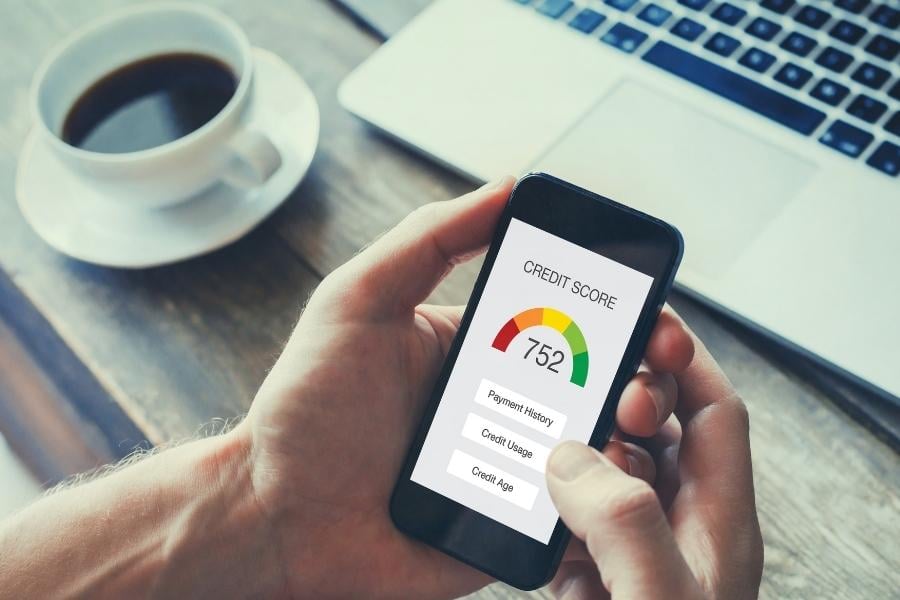7 Steps to Help Rebuild Your Credit Score
It's common knowledge that your credit score can be negatively impacted by even a few missed credit card payments or borrowing too much money. Though it’s much harder and takes more patience, you can also increase your score—thank goodness that one unfortunate decision doesn't have to define your financial health forever!
If you find yourself in this boat, here's what you need to know to recover your credit score.

Credit Basics
What makes up your credit score?
Your credit score isn’t a random calculation of your financial worthiness. There’s a method to the madness. Before you can rebuild your credit score, understand what factors influence it so that you can focus your efforts in the right direction.
These are the key factors that make up your credit score:
- Payment history: 35%
- Credit utilization: 30%
- Length of history: 15%
- Types of credit: 10%
- New credit: 10%
Identify the problems with your credit score. Do you have a history of late payments? Do you max out the limits on your credit cards? Do you open new credit cards often?
Once you begin to understand what caused your score to fall, you can follow these steps to correct the course.
 Photo from Canva
Photo from Canva
How to Raise Your Credit Score
1) Dispute errors on your credit report.
Carefully look at your credit report. We’re all human (yes, even the people handling and recording debts), and there’s always a chance that someone made a mistake on your report. If you find one, the Federal Trade Commission (FTC) has a well-laid path for you to get it corrected:
Step 1: Notify the credit reporting company which information you think is inaccurate. Use the FTC's sample dispute letter to ensure you include all essential information. Include copies, not originals, of documents that support your position."Both the credit bureau and the business that supplied the information to a credit bureau have to correct information that’s wrong or incomplete in your report. And they have to do it for free. To correct mistakes in your report, contact the credit bureau and the business that reported the inaccurate information. Tell them you want to dispute that information on your report." -Federal Trade Commission Consumer Advice
- The credit bureau has thirty days to investigate.
- They are required to provide you with the results of their investigation.
- They will forward the evidence you shared to the business that provided the report.
- Once the business investigates, they will share their results with the credit bureau which will then share them formally with you as well as provide you with a free credit report displaying the correct information. This free credit report does not affect your free annual report.
Step 2: Tell the information provider in writing that you dispute an item in your credit report. Use this sample dispute letter to inform the business that provided information about you to a credit reporting company.
For more information on this process and what's required, visit the FTC: Disputing Errors on Your Credit Reports.
 Photo from Canva
Photo from Canva
2) Carry less than your limit on your credit card.
Since credit utilization makes up 30% of your credit score, the lower the balance of your credit card, the better. Many follow the 30% rule, which advises consumers to spend up to 30% of their credit limit but not to exceed it. Even if you make regular payments, the high credit balance can negatively affect your credit score since utilization is a key part of your overall score.
3) Keep old accounts open.
The length of your credit history matters, so keep older accounts open and active, even if you don’t use them often. Check to make sure there are no associated fees.
4) Pay your bills on time.
Paying your bills on time is the best way to improve your credit score. If this is something that you struggle with, there are a few tools to help you create better habits.
- Set up auto-pay. Set up automatic payments for your bills, utilities, and credit lines so that they essentially pay themselves. Skeptical about this method of payment? Set a reminder on your phone to check your bank accounts a day or two later to ensure everything went through okay.
- Use a financial calendar. Don’t mix business with pleasure. Create a finance-only calendar to schedule payment days and set reminders.
- Account for processing time. Don’t forget that payments take time to process, especially if you use snail mail and checks. Send the money early enough so that if it takes 24-48 hours to process your payment, you’re still ahead of the due date.
 Photo from Canva
Photo from Canva
5) Become an authorized user on another account.
Have a family member or friend with impeccable credit? Although mixing family with personal finances isn’t always the best idea, becoming an authorized user can help raise your credit score. You don’t have to spend money or use their account to have your name associated with their positive financial footprint.
6) Get on the phone with your creditor.
Hopping on the phone with your creditor can help accomplish a few credit-impacting issues.
- Fix late payments. If you have a substantial history of making on-time payments, your creditor might be willing to waive the late fee and remove it from your report.
- Clear outstanding collection accounts. Call and let your creditors know you want to pay off your debt. If you suggest paying in full (if you can), they might be willing to work with you. Just make sure that they agree to remove negative marks from your report!
7) Pay off debt.
Get out of debt! There are a variety of approaches to help you get out of debt:
- Debt Snowball Method: This strategy involves paying off your smallest debts first, gaining momentum as you eliminate each one.
- Debt Avalanche Method: Focus on paying off debts with the highest interest rates first, which can save money on interest over time.
- Debt Management Plans (DMP): Through a credit counseling agency, enroll in a DMP which negotiates with creditors on your behalf and consolidates payments into a single monthly payment.
- Personal Loans: Some people consolidate high-interest debt into a lower-interest personal loan, making it easier to manage.
- Online Programs and Apps: Various apps and platforms like You Need a Budget (YNAB), Mint, or Tally help with budgeting and debt management.
- Financial Coaching: Hiring a financial coach can provide personalized guidance tailored to your situation.
Before engaging in one of these methods to get out of debt, it's suggested to speak with a financial advisor and research to ensure that you choose the one that best suits your needs and goals.
If your credit score dropped and you're in the thick of recovery to regain financial freedom, remember that paying off debt and rebuilding your score requires sacrifice and significant time, depending on how deep your debt goes. Set a plan and stick to it!






